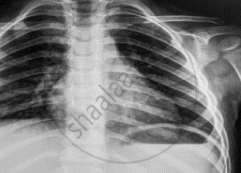Advertisements
Advertisements
प्रश्न
Identify the electromagnetic radiation and write its wavelength range, which is used to kill germs in water purified. Name the two sources of these radiations.
उत्तर
Radio waves, microwaves, infrared radiation, visible light, ultraviolet radiation, X-rays, gamma rays, and cosmic rays provide the whole range (electromagnetic spectrum) in increasing frequency and decreasing wavelength order. The type of radiation and their frequency and wavelength ranges are as follows:
| Types of Radiation | Frequency Range (Hz) | Wavelength Range |
| Gamma-rays | 1020 - 1024 | < 10-12 m |
| X-rays | 1017 - 1020 | 1 nm - 1 pm |
| Ultraviolet | 1015 - 1017 | 400 nm - 1 nm |
| Visible | 4 × 1014 - 7.5 × 1014 | 750 nm - 400 nm |
| Near-infrared | 1 × 1014 - 4 × 1014 | 2.5 µm - 750 nm |
| Infrared | 1013 - 1014 | 25 µm - 2.5 µm |
| Microwaves | 3 × 1011 - 1013 | 1 mm - 25 µm |
| Radio waves | < 3 × 1011 | > 1 mm |
In water purifiers, ultraviolet light is utilised to kill bacteria. The sun is the most powerful source of UV radiation.
UV lamps, arc welding, and mercury vapour lamps are examples of man-made ultraviolet sources. Carbon, Xenon, and other arcs are some of the devices that release UV radiation.
APPEARS IN
संबंधित प्रश्न
A wave has wavelength 50 Å.
- Name the wave.
- State its speed in vacuum.
- State its one use.
What do you understand by the statement, "Electromagnetic waves transport momentum"?
Characteristic X-rays may be used to identify the element from which they are being emitted. Can continuous X-rays be used for this purpose?
X-ray incident on a material
(a) exerts a force on it
(b) transfers energy to it
(c) transfers momentum to it
(d) transfers impulse to it.
Consider a photon of continuous X-ray and a photon of characteristic X-ray of the same wavelength. Which of the following is/are different for the two photons?
Name the scientist who discovered
X-rays
Arrange the following electromagnetic waves in increasing order of their frequencies (i.e. begin with the lowest frequency):
Visible light, y rays, X rays, microwaves, radio waves, infrared radiations, and ultraviolet radiation.
Name the part of the electromagnetic spectrum which is:
Produced by bombarding a metal target with high electrons.
A bat moving at 10 ms−1 towards a wall sends a sound signal of 8000 Hz towards it. On reflection, it hears a sound of frequency f The value of f in Hz is close to (speed of sound = 320 ms−1)
Name the electromagnetic radiation that has been used in obtaining the image below.

